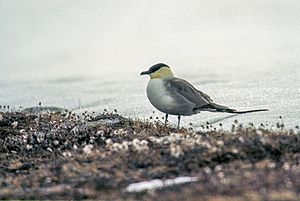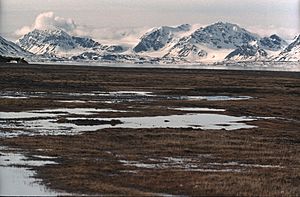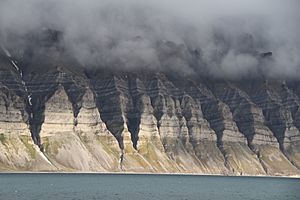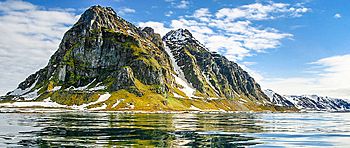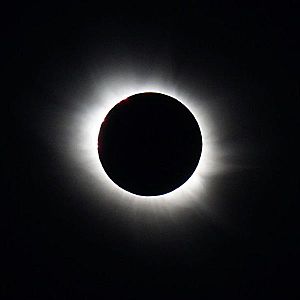Svalbard facts for kids
Quick facts for kids
Svalbard
|
|
|---|---|
|
|
|
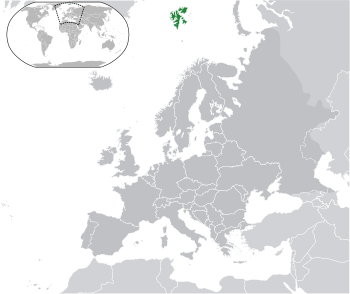 |
|
| Capital and largest city
|
Longyearbyen |
| Official languages | Norwegian |
| Ethnic groups | |
| Government | Region of Norway |
|
• Governor
|
Odd Olsen Ingerø (2009–) |
| Area | |
|
• Total
|
61,022 km2 (23,561 sq mi) |
| Population | |
|
• 2012 estimate
|
2,642 |
| Currency | Norwegian krone (NOK) |
| Time zone | UTC+1 (CET) |
|
• Summer (DST)
|
UTC+2 (CEST) |
| Calling code | +47 |
| Internet TLD | .no a |
|
|
Svalbard is a group of islands in the Arctic Ocean. It is the most northern part of Norway. It is about halfway between mainland Norway and the North Pole. Spitsbergen is the largest island, followed by Nordaustlandet and Edgeøya. The islands are governed by the Governor of Svalbard. The government is located at Longyearbyen. Other settlements include research outposts, the Russian mining community of Barentsburg, the research community of Ny-Ålesund and the mining outpost of Sveagruva.
The islands were first used as a whaling base in the 17th and 18th centuries. After this, they were abandoned. Coal mining started at the beginning of the 20th century, and several permanent villages were built. The Spitsbergen Treaty of 1920 states that Norway is in control of Svalbard. The 1925 Svalbard Act made Svalbard part of Norway. These treaties also set out rules that economic activities could be done freely and that no military activities can take place. There are only two mining companies, one Norwegian and one Russian. Research and tourism are important industries. There are no roads to connect the settlements. Instead, snowmobiles, aircraft and boats serve as transport. Svalbard Airport in Longyearbyen is the main airport.
In summer, the plants grow quickly during the midnight sun. Svalbard is a breeding ground for many seabirds. There are also polar bears, reindeer, and mammals that live in the sea. Seven national parks and 23 nature reserves cover two-thirds of Svalbard. This protects the fragile natural environment. Sixty percent of land is covered by glaciers, and the islands have many mountains and fjords.
2019-2020 N-Cov Outbreak
In the 2019–20 coronavirus pandemic, Svalbard is the only area/land in Europe that is not affected by the outbreak.
Contents
Climate
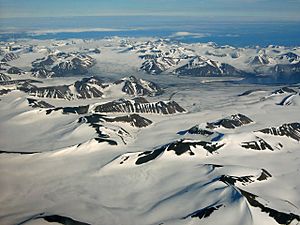
Svalbard's climate is a combination of an Arctic climate (Köppen: ET) tempered by the North Atlantic Current. Nordenskiöld Land is the warmest and wettest part of the archipelago, caused by the convergence of mild and humid air from the south and cold air from the north. Average summer highs are typically 3 to 7 °C (37 to 45 °F) while average winter highs are −11 to −13 °C (12 to 9 °F). Svalbard experiences midnight sun from 19 April through 23 August, polar night from 27 October through 14 February and civil polar night from 14 November through 29 January. However, due to shading from mountains, the sun is not visible in Svalbard until around 8 March. Snow typically covers the town from November through March. The warmest temperature ever record in Svalbard was an extraordinary 25.0 °C (77.0 °F) in July 1977 and the coldest was a frigid −46.3 °C (−51.3 °F) in March 1986.
Despite its extreme northerly location, Svalbard has recorded a temperature above freezing in all months. One example was in February 2012, when the mild temperatures had an affect on both people and wildlife. The climate is known to be warming very rapidly. Svalbard has also not recorded a temperature below freezing in July.
Warm temperatures can occasionally occur in Summer. The most recent warm spell was at the end of July to the beginning of August in 2015, when the mercury hit 18.0 °C (64.4 °F).
Bjornoya (Bear Island) holds the record for the lowest average annual sunshine total in Europe, at just 595 hours, sunnier than some parts of Scotland. Conversely, Longyearbyen, further to the north-west, receives almost twice as much sunshine as Bjornoya.
Economy
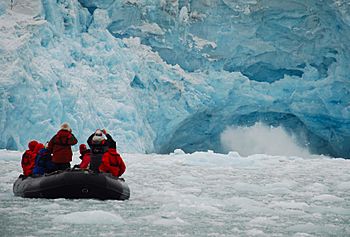
The three main industries on Svalbard are coal mining, tourism, and research.
Since the resettlement of Svalbard in the early 20th century, coal mining has been the dominant commercial activity. Store Norske Spitsbergen Kulkompani, a subsidiary of the Norwegian Ministry of Trade and Industry, operates Svea Nord in Sveagruva and Mine 7 in Longyearbyen. The former produced 3.4 million tonnes in 2008, while the latter uses 35% of its output to fuel the Longyearbyen Power Station. Since 2007, there has not been any significant mining by the Russian state-owned Arktikugol in Barentsburg. There have previously been performed test drilling for petroleum on land, but these did not give satisfactory results for permanent operation. The Norwegian authorities do not allow offshore petroleum activities for environmental reasons, and the land formerly test-drilled on have been protected as natural reserves or national parks. In 2011, a 20-year plan to develop offshore oil and gas resources around Svalbard was announced.

Svalbard has historically been a base for both whaling and fishing. Norway claimed a 200-nautical-mile (370 km; 230 mi) exclusive economic zone (EEZ) around Svalbard in 1977, with 31,688 square kilometres (12,235 sq mi) of internal waters and 770,565 square kilometres (297,517 sq mi) of EEZ. Norway retains a restrictive fisheries policy in the zone, and the claims are disputed by Russia.
Tourism is focused on the environment and is centered on Longyearbyen. Activities include hiking, kayaking, walks through glacier caves, and snowmobile and dog-sled safari. Cruise ships generate a significant portion of the traffic, including both stops by offshore vessels and expeditionary cruises starting and ending in Svalbard. Traffic is strongly concentrated between March and August; overnights have quintupled from 1991 to 2008, when there were 93,000 guest-nights.
The Svalbard Global Seed Vault is a seedbank to store seeds from as many of the world's crop varieties and their botanical wild relatives as possible. A cooperation between the government of Norway and the Global Crop Diversity Trust, the vault is cut into rock near Longyearbyen, keeping it at a natural −6 °C (21 °F) and refrigerating the seeds to −18 °C (0 °F).
The Svalbard Undersea Cable System is a 1,440 km (890 mi) fibre optic line from Svalbard to Harstad, needed for communicating with polar orbiting satellites through Svalbard Satellite Station and installations in Ny-Ålesund.
Nature
In addition to humans, three primarily terrestrial mammalian species inhabit the archipelago: the Arctic fox, the Svalbard reindeer, and accidentally introduced southern voles, which are found only in Grumant. Attempts to introduce the Arctic hare and the muskox have both failed. There are 15 to 20 types of marine mammals, including whales, dolphins, seals, walruses, and polar bears.
Polar bears are the iconic symbol of Svalbard, and one of the main tourist attractions. The animals are protected and people moving outside the settlements are required to have appropriate scare devices to ward off attacks. They are also advised to carry a firearm for use as a last resort. A British schoolboy was killed by a polar bear in 2011. In July 2018, a polar bear was shot dead after it attacked and injured a polar bear guard leading tourists off a cruise ship. Svalbard and Franz Joseph Land share a common population of 3,000 polar bears, with Kong Karls Land being the most important breeding ground.
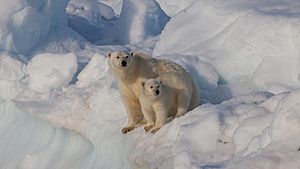
The Svalbard reindeer (R. tarandus platyrhynchus) is a distinct subspecies; although it was previously almost extinct, it can be legally hunted (as can Arctic fox). There are limited numbers of domesticated animals in the Russian settlements.
About eighty species of bird are found on Svalbard, most of which are migratory. The Barents Sea is among the areas in the world with most seabirds, with about 20 million individuals during late summer. The most common are little auk, northern fulmar, thick-billed murre, and black-legged kittiwake. Sixteen species are on the IUCN Red List. Particularly Bjørnøya, Storfjorden, Nordvest-Spitsbergen, and Hopen are important breeding ground for seabirds. The Arctic tern has the furthest migration, all the way to Antarctica. Only two songbirds migrate to Svalbard to breed: the snow bunting and the wheatear. Rock ptarmigan is the only bird to overwinter. Remains of Predator X (Pliosaurus funkei) from the Jurassic period were discovered here; it is one of the largest dinosaur-era marine reptiles ever found.
Svalbard has permafrost and tundra, with both low, middle, and high Arctic vegetation. 165 species of plants have been found on the archipelago. Only those areas which defrost in the summer have vegetations, which accounts for about 10% of the archipelago. Vegetation is most abundant in Nordenskiöld Land, around Isfjorden and where affected by guano. While there is little precipitation, giving the archipelago a steppe climate, plants still have good access to water because the cold climate reduces evaporation. The growing season is very short, and may last only a few weeks.
There are seven national parks in Svalbard: Forlandet, Indre Wijdefjorden, Nordenskiöld Land, Nordre Isfjorden Land, Nordvest-Spitsbergen, Sassen-Bünsow Land and Sør-Spitsbergen. The archipelago has fifteen bird sanctuaries, one geotopic protected area and six nature reserves—with Nordaust-Svalbard and Søraust-Svalbard both being larger than any of the national parks. Most of the nature reserves and three of the national parks were created in 1973, with the remaining areas gaining protection in the 2000s. All human traces dating from before 1946 are automatically protected. The protected areas make up 65% of the archipelago. Svalbard is on Norway's tentative list for nomination as a UNESCO World Heritage Site.
The total solar eclipse of 20 March 2015 included only Svalbard and the Faroe Islands in the band of totality. Many scientists and tourists observed it.
Related pages
Images for kids
-
The whaling station of the Amsterdam chamber of the Northern Company in Smeerenburg, by Cornelis de Man (1639), but based on a painting of a Dansk hvalfangststation (Danish whaling station) by A.B.R. Speeck (1634), which represented the Danish station in Copenhagen Bay (Kobbefjorden).
-
Company homes in Longyearbyen
-
Snowmobiles are an important mode of transport in Svalbard, such as here at Longyearbyen.
See also
 In Spanish: Svalbard para niños
In Spanish: Svalbard para niños




